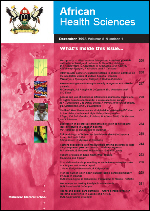
|
African Health Sciences
Makerere University Medical School
ISSN: 1680-6905
EISSN: 1680-6905
Vol. 17, No. 1, 2017, pp. 1-6
|
 Bioline Code: hs17001
Bioline Code: hs17001
Full paper language: English
Document type: Research Article
Document available free of charge
|
|
|
African Health Sciences, Vol. 17, No. 1, 2017, pp. 1-6
| en |
Proportion and factors associated with low fifth minute Apgar score among singleton newborn babies in Gondar University referral hospital; North West Ethiopia.
Temesgen Worku Gudayu
Abstract
Back ground: New born babies with low Apgar scores are at an increased risk of perinatal morbidity and mortality.
Objective: To assess proportion and factors associated with low 5th minute Apgar Apgar score among singleton newborn babies
in Gondar University referral hospital; North West Ethiopia.
Methods: A cross-sectional study was conducted on singleton 261 live births from March - May, 2013. Data was collected from
mother/newborn index using a structured and pre-tested questionnaire. It was then cleaned, coded and entered using EPI INFO
version 3.4.3, then analyzed with IBM SPSS statistics versions 20.0. Logistic regression was used to identify significant variables
with low 5th minute Apgar score.
Result: The proportion of low 5th minute Apgar score in this study was 13.8%. Factors that were significantly associated with
low 5th minute Apgar score were: non-vertex fetal presentation, prolonged labor, presence of meconium stained liquor, induced/
augmented labor and low birth weight.
Conclusion: Mainly obstetric factors contribute to low Apgar score. Improving labor management through implementing regular
use of partograph, 1:1 midwife-client ratio and advanced electronic fetal monitoring technology is recommended.
Keywords
Apgar score; Gondar University referral hospital
|
| |
© Copyright [2017] - African Health Sciences
|
|
